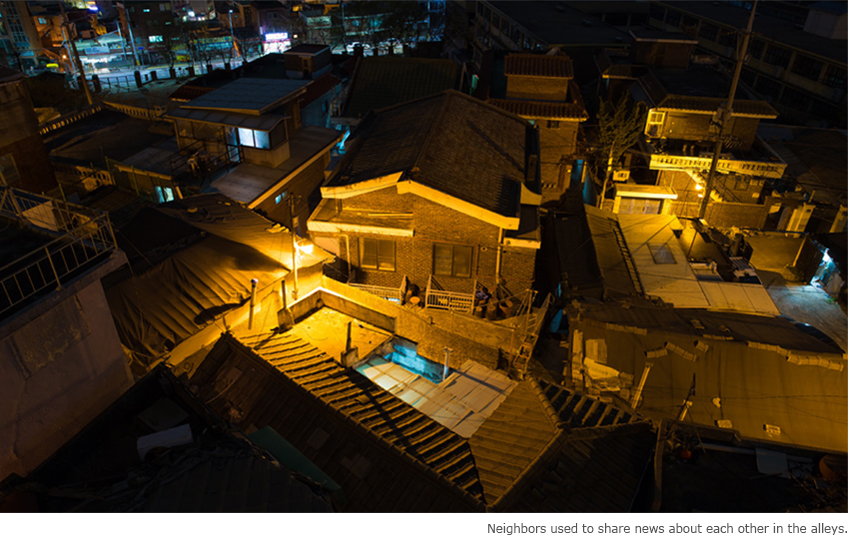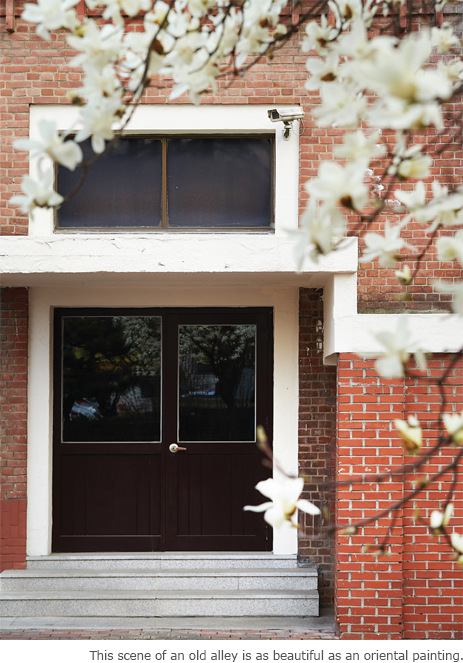

Alleys Revived
“Gildong, it’s time to eat!” When there's no response, the mother would call again to her child in a louder voice. “Gildong-a! I said it’s time for dinner!” This is not a cell phone conversation. The mother was standing at the front gate and shouting down the alley. Why was she looking for her kid in the alley at mealtime?
Written by Park Ji-yeon Photographed by Studio Kenn

Call and Response, an Alley Custom
Why did the mother holler down the alley for her child to come home for dinner? This is a typical scene from “Reply 1988” (2015, tvN), a popular TV show based on real life. It is set in the year 1988 when the alleys were noisy with parents calling out to their children. The mother was hoping for her kid, who was most likely visiting a friend in one of the houses along the alley, to come back in time for dinner. Upon hearing their mother’s call, the child would shout back, “I’m coming!” and rush back home. This call-and-response was made possible by the intimate space of the city's narrow alleyways.
Where Neighbors Exchange News
In the show “Reply 1988,” you often see homemakers sitting in the alley on a low, wooden platform called a pyeongsang. A few passersby would sometimes join in. They would then start to exchange bundles of stories.
The alley exchange doesn't stop here, but continues to spread into each neighbor’s daily life. The alley was a major source of neighborhood gossip. Since the internet and smartphones weren't yet common in those days, the alley helped to deliver news and sustain a community spirit.

Gone, but not Forgotten
At some point, large rectangular apartment complexes began replacing older homes with their low fences. People flocked to higher, newer abodes, leaving behind the old ramshackle houses in the alleyways. With more and more detached houses going vacant, the alleys lost the energy they once had. Humans are social animals, and by nature we are attracted to communities. In the early 1990s, a few people started to leave the alleys of Ssangmun-dong, in Dobong-gu District, Seoul, the backdrop for the show “Reply 1988.” Sure enough, everyone else soon followed.
The TV show shows the importance of alleyways in the lives of newly urbanized people of the 1980s and 1990s. It was in the alley that parents watched their children grow, kids created happy memories of childhood, and neighbors built a sense of community. The word “reply” in the show's name indicates a yearning for the past. Alleys, which have gradually faded from our lives, are fondly remembered today.



Gamcheon Cultural Village,
Home to the Same Villagers
Busan’s Gamcheon Cultural Village, which attracted more than 2 million visitors last year, is a successful case of urban regeneration. The original form of the neighborhood, including detached houses and crooked alleyways, has been maintained. The greatest achievement of the project is that the neighborhood is still home to the same people as before. Residents weren't made homeless or forced to leave for the sake of urban renewal. Thanks to such regeneration efforts, the residential neighborhood has gained status as a major tourist attraction.
Spread across the hill is a jumbled yet glorious amalgam of pastel-toned houses, arranged so that one doesn't obstruct the other. The neighborhood has even accepted new residents. With the alleys now rejuvenated, people have naturally begun to return.
Alleys Revived
Alleyways have come under the spotlight in recent times. You may be curious how they made their return. It's the result of infusing the old residential lanes with public art and murals that are attractive enough to lure people back, and to invite them to linger. You will find beautiful artist-created murals in the official Mural Alleys, a creative colony of artists in the Artists’ Alleys, hip and trendy cafes in the Cafe Alleys, old bookstores in the Secondhand Bookstore Alleys, and traditional Hanok homes along the Hanok Alleys. There are Modern Alleys, Shoe Alleys, Market Alleys and the list goes on. One greeting you will now hear is, “Have you been to the So-and-so Alley?”
There are growing concerns over the recent explosion of alleys as demonstrating excessive commercialization. Gentrification is another worrisome issue. Whatever the case, alleys have returned. Returning was the most difficult part. If people, too, now return and put their heads together for a solution, we will soon be able to restore laughter to the alleys.


Other Articles




Odaesan Mountain,
Pyeongchang’s Treasure

Hooked on Hangeul

Designed To Be ‘Held’


Eomuk Fishcakes


With Culture N Tickets
Application of subscription
Sign upThe event winners
Go






